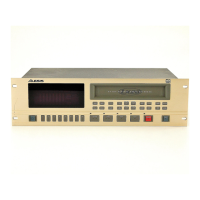Chapter 10 - Multiple LX20/ADAT Operation
ADAT LX20 Reference Manual 61
put the new tape into the master, the damaged tape in the slave, and copy from the slave to
the master.
MAKING A 16-BIT COPY FROM A 20-BIT MASTER
With over 100,000 ADAT 16-bit Type I machines in use, you may need to trade tapes
with someone who owns an older machine. You can still record with your LX20 in 20-
bit Type II mode, and make Type I-compatible “clones.” You can also use an older
Type I machine as a slave to an LX20.
Alesis recommends creating 16-bit copies using dithering, a process that provides
better apparent resolution than standard 16-bit copies, unless the tape will be re-
dithered later on. The process is the same as making a standard backup, except that
you select a dithered 16-bit digital output at the master, as described in Chapter 8.
RECORDING DIGITAL AUDIO FROM OTHER SOURCES
Recording digital audio onto the LX20 from a source other than an ADAT-
compatible device requires a digital audio interface, like the Otari UFC-24 or
Kurzweil DMTi. These convert other digital audio formats to the Alesis Optical
format. The ADAT-PCR card can also output audio recorded into a hard disk
editing program as ADAT Optical Interface data.
When recording digital audio into the LX20 within a multiple ADAT system, the
LX20 recording the audio (whether slave or master) is already synchronized with
the other machines because all slave machines are automatically set to External
Clock mode (EXT indicator lights in the Clock block). This means they follow the
master precisely.
When recording digital audio from some other source, the LX20 must synchronize to
the incoming digital audio. The procedure for doing this depends on whether you are
using a single LX20 or a multiple ADAT system. We will assume the incoming
digital audio is being carried by an ADAT Optical interface cable (perhaps from an
ADAT-PCR card).
With a single LX20, connect the ADAT-PCR card’s OPTICAL OUT to the LX20’s
DIGITAL IN using a single fiber optic connector. Press the LX20’s DIGITAL INPUT
button, and set its Clock Source to Digital (press CLOCK SELECT until the DIG
indicator lights in the Clock block). The LX20 will synchronize to the OPTICAL
OUT clock information.
In a multiple ADAT system, you have two choices: synchronize the digital audio
source to the ADAT system (as described above for a single ADAT), or sync the
ADAT system to the digital audio source.
If the source cannot sync to an external clock, you need to choose the latter option.
Connect the OPTICAL OUT to the master ADAT’s DIGITAL IN, whose DIGITAL
OUT already connects to the next slave’s input, and so on. Set the master’s Clock
Source to Digital (press CLOCK SELECT until the DIG indicator lights in the
CLOCK block). If no digital audio clock is detected, the master LX20’s DIG
indicator will flash and it will continue using its own internal clock. When the
master receives digital audio, the master LX20 will sync to the incoming digital
clock. The LX20’s DIG clock indicator will stop flashing and remain lit.

